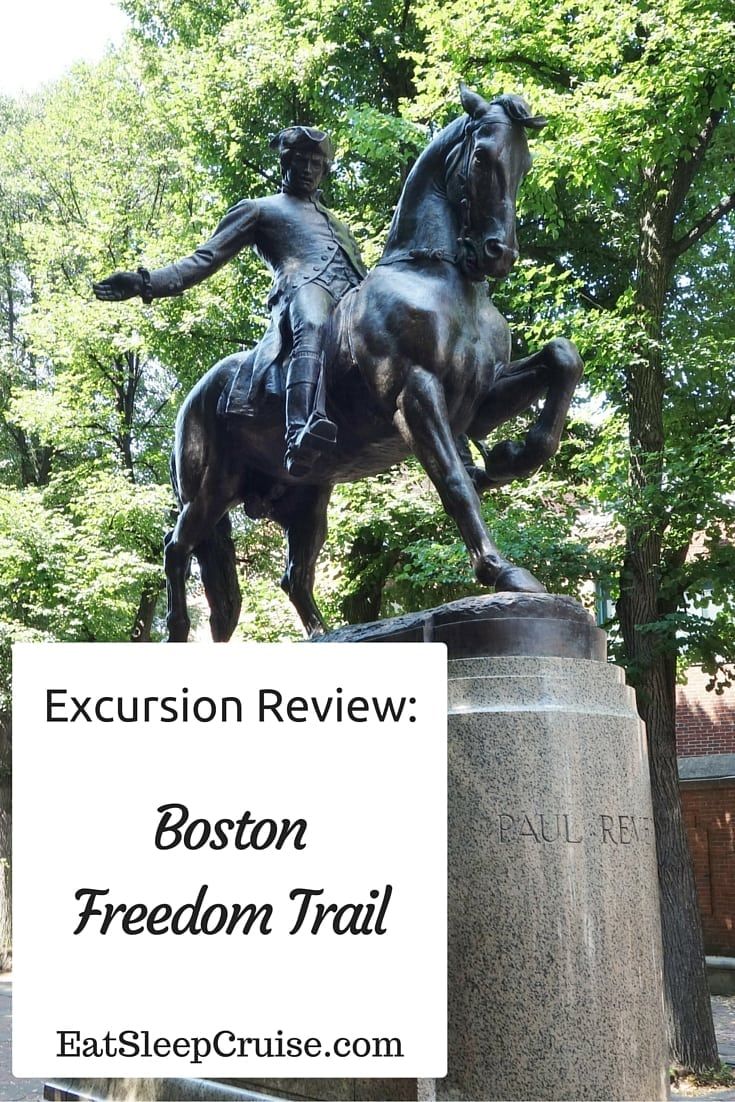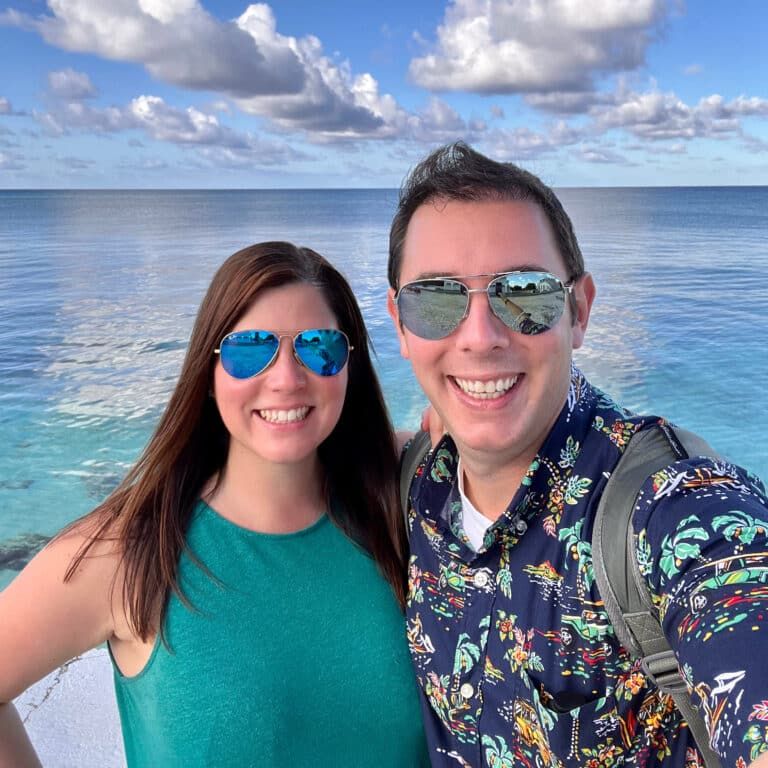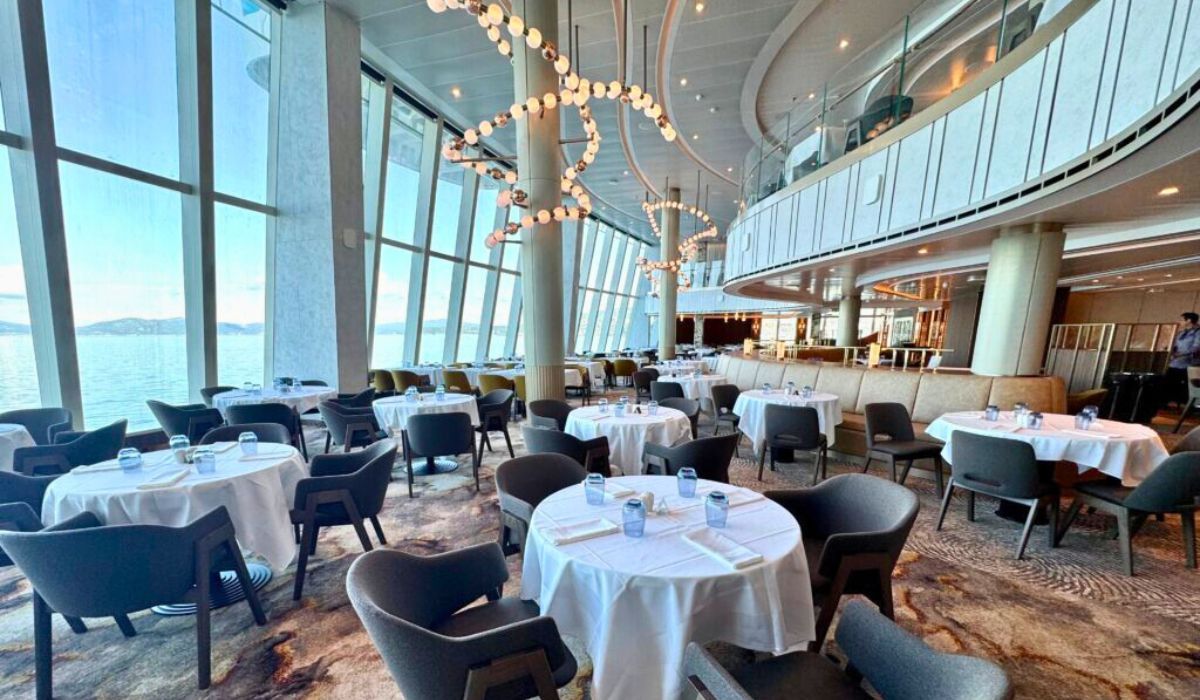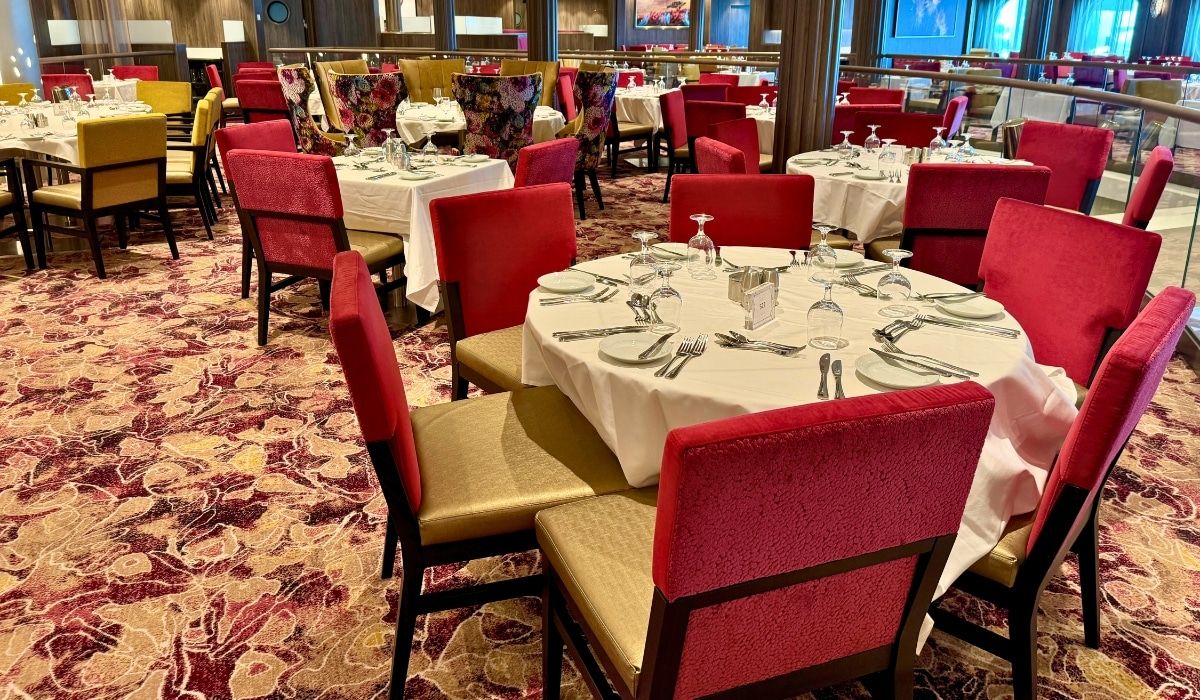As one of America’s oldest cities, Boston is home to many notable and historically significant sites. With the founding of the city by Puritans in 1630, Boston played a crucial role in the birth of the United States and the American Revolution.
Lucky for you, the great people of Boston have made it their duty to preserve and share this history with those who visit Boston, by land or by sea.
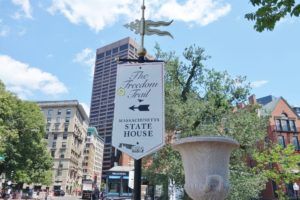 A Marker Indicating One of the First Stops on the Boston Freedom Trail
A Marker Indicating One of the First Stops on the Boston Freedom Trail
Of all of the ways travelers can experience the Boston of yesteryear, the Boston Freedom Trail is perhaps the most popular. Whether you book a tour lead by expert guides wearing authentic colonial costumes, or you decide to take a self guided tour using publicly available maps and audio guide, the Boston Freedom Trail is the perfect shore excursion for your pre-cruise or post cruise tour.
On a recent summer day, we traveled the short hour from our home town to retrace the footsteps of the brave men and women who helped defend the young colony and eventually sparked a revolution.
Self Guided Tour of the Boston Freedom Trail
Beginning our Trek on the Boston Freedom Trail
While some of the sites on the Boston Freedom Trail date back to the 17th century, the foundation that maintains these 16 sites and is in charge of organizing tours and educational programs is less than 70 years old. Started in the 1950s to ensure that these American treasures were preserved, the Boston Freedom Trail is now one of the city’s most popular attractions, with an estimated 4 million visitors a year.
The 2.5 mile walk begins in the Boston Common.
If you do not already have a map or guide, you can make your way to the Visitor Center, near Tremont Street, to grab some free literature. You may also be tempted to purchase a tour from one of the tour guides strategically stationed near the Center.
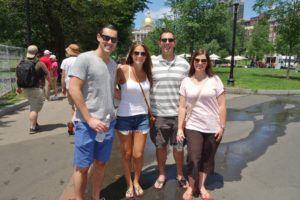 Getting Read to Start the Freedom Trail in the Boston Common
Getting Read to Start the Freedom Trail in the Boston Common
Here, in the Boston Common, America’s oldest public park with a total area of almost 50 acres, you will start your historic journey back in time. While the Boston Common has seen a variety of uses in the past, from a grazing area for cattle and sheep, to a place to hang pirates and witches, today, the Common can be used to relax or catch a concert.
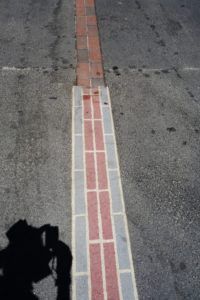 Following the Boston Freedom Trail’s Red Brick Path
Following the Boston Freedom Trail’s Red Brick Path
Following the red brick line (no, not the yellow brick road), your next stop on the trail is the Massachusetts State House. One of the oldest buildings on Beacon Hill, it was designed by Charles Bulfinch and completed in 1798.
 MA State House on the Freedom Trail
MA State House on the Freedom Trail
It is now considered a National Historic Landmark for its architectural significance. The dome has seen some changes over the years, originally made of wood, overlaid with copper, then finally covered in 23 karat gold leaf in 1874. Here, the senators, state representatives, and governor conduct daily business.
Sparking a Revolution
Exiting the Common, we headed northeast on Tremont Street to our next stop, the Park Street Church. Founded in 1809, the church is located on “Brimstone Corner”- named partly because it once housed brimstone, a component of gun powder, in its basement during the War of 1812, and partly because preachers gave fire and brimstone speeches to the congregation here.
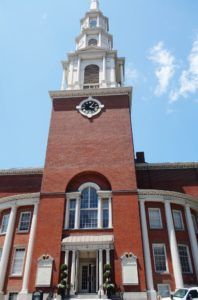 Facade of Park Street Church
Facade of Park Street Church
The Park Street Church became known as the church of firsts: first Sunday school in 1818, first prison aid in 1824, first anti-slavery speech in 1829, and “My Country Tis of Thee” was sung here for the first time in 1831.
Adjacent to the church is the Granary Burying Ground, the third oldest burial ground in Boston, established in 1660.
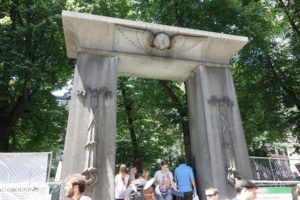 Entrance to Granary Burying Ground, Currently Undergoing Restoration
Entrance to Granary Burying Ground, Currently Undergoing Restoration
The burying ground is a resting place for many notable Americans including: John Hancock, Ben Franklin’s parents, and Revolutionary heroes Samuel Adams, Paul Revere, and James Otis.
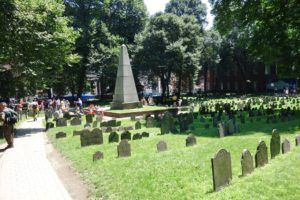 Tombstones of Prominent Bostonians at Granary Burying Ground.
Tombstones of Prominent Bostonians at Granary Burying Ground.
The grounds are also the final resting place for Peter Faneuil, a wealthy American colonial who donated Faneuil Hall to Boston, and an estimated 5,000 other people who are also buried here.
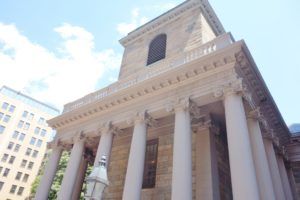 Outside of King’s Chapel
Outside of King’s Chapel
About a block north of these sites is the fifth stop on the Boston Freedom Trail, the King’s Chapel and Burying Ground. Founded in 1688, this church was the first non-Puritan church in Boston. Still in use today, the Chapel houses the oldest American pulpit in continuous use.
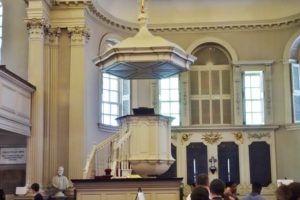 The Pulpit in King’s Chapel
The Pulpit in King’s Chapel
The interior is considered the finest example of Georgian architecture in North America, with its 2,347 pound bell created by Paul Revere in 1816. The chapel was designated a National Historic Landmark in 1960 for its architectural significance.
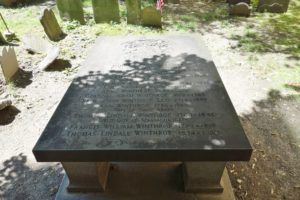 First Governor of Boston is Buried in King’s Chapel Burying Ground
First Governor of Boston is Buried in King’s Chapel Burying Ground
Next to the chapel is the Burying Ground which was the only burial ground in Boston for nearly 30 years. Among those who call these grounds their final resting place is James Winthrop, MA’s first and 12 term governor, and Mary Chilton, the first woman to step off the Mayflower.
More Firsts Along the Boston Freedom Trail
Continuing on the trail, directly behind the Chapel, you come across the former site of the Boston Latin School and Benjamin Franklin Statue. America’s first public school established in 1635 by Puritan settlers, it is also the oldest existing school in the United States, schooling boys only until 1972. A mosaic now marks the spot where the school once stood along with a statue of Benjamin Franklin.
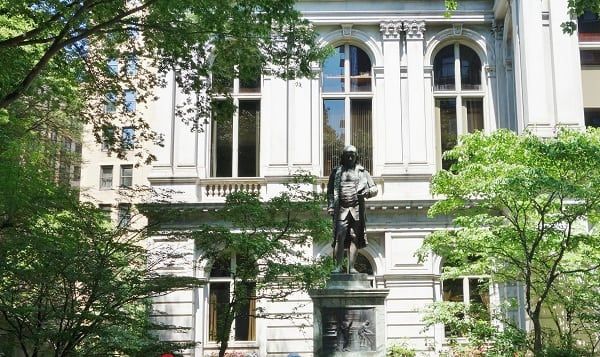 Statue of Ben Franklin Overlooks the Marker Signifying the Home of the First Boston Latin School
Statue of Ben Franklin Overlooks the Marker Signifying the Home of the First Boston Latin School
Notable students who attended the school include Benjamin Franklin, Samuel Adams, and John Hancock. The Boston Latin School is still in operation in the Fenway district of Boston today and is currently ranked as one of the top 100 high schools in the United States.
A block down from the former Latin School sits the former Old Corner Bookstore. Now a Chipotle, the building, with a history dating back to 1638, is Boston’s oldest commercial building. The building was first used as a bookstore in 1828 and later became the home of Ticknor and Fields publishing company. As the center for book publishing in the 1800’s, this publishing house introduced authors such as Henry David Thoreau, Ralph Waldo Emerson, and Mark Twain.
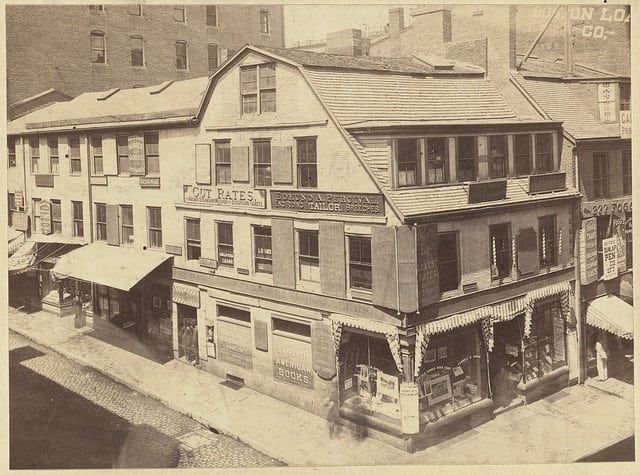 Old Corner Bookstore Circa 1900 (source)
Old Corner Bookstore Circa 1900 (source)
Across the street from the bookstore resides Old South Meeting House. Built in 1729 as a place of worship, it was the largest building in colonial Boston, where colonists assembled to challenge British rule- most famously to protest the Boston Massacre and the tea tax which was the start of the Revolution with the infamous Boston Tea Party.
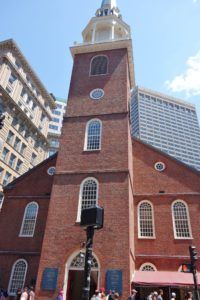 The Front of the Old South Meeting House on Boston Freedom Trail
The Front of the Old South Meeting House on Boston Freedom Trail
The building was slated for demolition in 1876, but it was preserved by Boston citizens. Now, it is open daily as a museum.
Heading north a full city block, travelers on the Boston Freedom Trail encounter the Old State House. Originally constructed in 1713 to house the colony’s government, the House is the oldest surviving public building in Boston and was designated a National Historic Landmark in 1960.
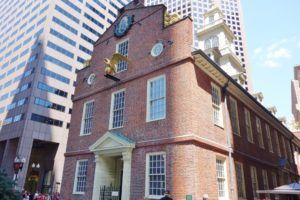 Oldest Public Building in Boston
Oldest Public Building in Boston
From the balcony of the Old State House, the Declaration of Independence was first read to the people of Boston in 1776. The seat of Massachusetts government resided here until the new State House was built on Beacon Hill in 1798. Today, the building is run by the Bostonian Society where you can visit the American Revolutionary Museum, watch live performances, and sit in the Royal Governor’s chair for the small admission fee.
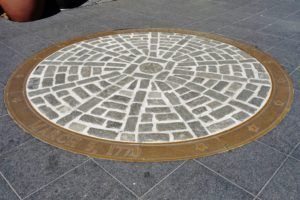 Site of the Boston Massacre in 1770
Site of the Boston Massacre in 1770
Located right outside of the Old State house is the Boston Massacre Site. Now commemorated by a circle of cobblestones, the site is the location where on March 5, 1770, 9 British “redcoats” and a mob of Bostonians feuded over the occupation of British forces, which resulted in open fire and 5 Bostonian casualties.
Called an “Unhappy Disturbance at Boston” by the British but “a bloody massacre” by Paul Revere, his illustrative propaganda of this event stirred up more anti-British sentiment, which would eventually lead the colony into war against Great Britain.
Making our way into one of the most popular, and populous, areas in Boston, the 11th stop on the Boston Freedom Trail is Faneuil Hall. Built by wealthy merchant Peter Faneuil in 1741, it was one of America’s first public meeting venues.
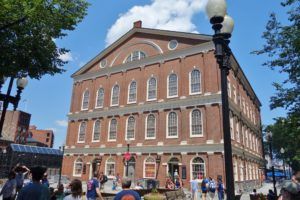 The “New” Faneuil Hall
The “New” Faneuil Hall
Often referred to as the “home of free speech” and the “cradle of liberty”, many inspirational speeches were given here by Sam Adams, James Otis, and other Patriots on independence. Even today, artists, performers, public speakers, and ralliers congregate at Faneuil Hall.
 The Mobs at Quincy Market
The Mobs at Quincy Market
In 2008, Faneuil Hall was ranked as one of the 25 top American tourist sites by Forbes Traveler, and it has been designated a National Historic Landmark since 1960. Now part of a larger Faneuil Hall marketplace, it consists of North Market, South Market, and Quincy Market.
Heading to The North End
There is a good stretch between Faneuil Hall and the next few sites on the Boston Freedom Trail. In fact, if you take most tours that depart from the Boston Common, your tour will end at Faneuil Hall. But, since we were taking this walk on our own, and determined to see all 16 sites, we traveled on toward the North End and the next stop, the Paul Revere House.
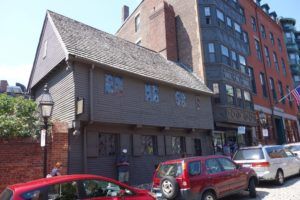 The Paul Revere House in the North End
The Paul Revere House in the North End
After a solid quarter of a mile walk, we arrived at 19 North Square. Built in 1860, the Paul Revere House is the oldest remaining residential structure in downtown Boston, and it is the only residence on the Boston Freedom Trail. Purchased by Paul Revere in 1770, it was home to the Revere family until 1800. For most of the 1800’s, it served as a rooming house for Irish, Jewish, and Italian immigrants, until being restored and opened to the public in 1908.
The site is now owned and operated by The Paul Revere Memorial Association and is a museum and historic site that can be viewed with a small admission fee. Don’t be surprised if there is a long line to get in to see the house. While we were interested in touring, given the long line, we decided to make only a quick photo op and ventured further to see the few remaining sites.
Continuing northeast, you arrive at one of the most iconic stops on the trail, the Old North Church. Founded in 1722 as the Christ Church in the City of Boston, it is the oldest church building in Boston.
 The Steeple of the Old North Church
The Steeple of the Old North Church
The Old North Church’s fame can be attributed to poet Henry Wadsworth Longfellow’s The Midnight Ride of Paul of Revere. It was on this church steeple, rising 191 ft. into the air as the tallest steeple in Boston, that lantern signals were given to warn of the British approach- 2 lanterns were held high to signal that the British were approaching Lexington and Concord by sea, thus starting the American Revolution.
Today, visitors can view the high box pews, the brass chandelier, and the clock which are all original to this church. The Old North Campus also includes The 1713 Clough House, one of Boston’s oldest brick residences.
Continuing up Hull Street, we were not able to tour the Copp’s Hill Burying Ground as entrances were closed due to renovation and construction.
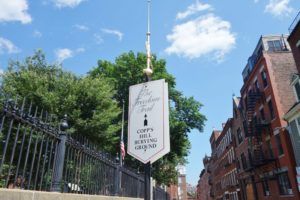 Marker Indicating the Burying Ground
Marker Indicating the Burying Ground
Founded in 1659 as Windmill Hill, this burying ground is Boston’s second oldest burying ground, later named after shoemaker William Copp who once owned the land. These grounds are the final resting place of North End residents including fire-and-brimstone preachers Cotton and Increase Mather and Old North Church sexton Robert Newman known for hanging the lantern signals from Paul Revere. Of note, this was not an original site on the Boston Freedom Trail when established in 1951.
On to Charlestown for the Final Stops on the Trail
The last few stops on the Boston Freedom Trail are located just outside of Boston, in Charlestown. You will be hard pressed to find a tour that takes you to all of the sites, as the stretch from the Copp’s Burying Ground to one of the Charlestown stops is a solid mile, making you cross the Charles River.
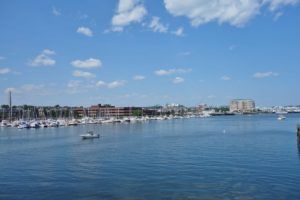 A View Across the River
A View Across the River
Getting a bit tired from a close to three hour trek through the city, we were not going to let the last two stops on the Boston Freedom Trail elude us. Taking our time maneuvering through the city and over the North Washington Street Bridge, we finally made it to Charlestown, heading to see one of the two sites on this peninsula.
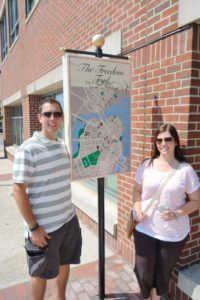 The Princess and I Made it This Far on the Boston Freedom Trail
The Princess and I Made it This Far on the Boston Freedom Trail
Here, you have two options, as the trail splits and circles around the area. We headed right, towards the USS Constitution and the Charlestown Naval Yard.
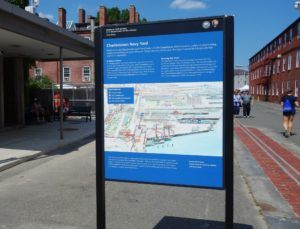 Entering Federal Territory and the USS Constitution
Entering Federal Territory and the USS Constitution
Some of those in our party were adamant that we were not heading in the right direction. Even though the red brick line was still in effect, it arguably resembled just “a design in the sidewalk”. Doubters aside, we did arrive at the Charlestown Naval Yard, and we were met with a bit of a line.
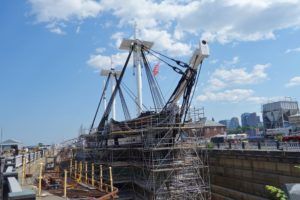 USS Constitution in Dry Dock Undergoing Restoration
USS Constitution in Dry Dock Undergoing Restoration
The thirty acres of the Navy Yard are preserved by the National Park Service as part of the Boston National Historical Park. Here, you can find the USS Constitution and the USS Cassin Young.
As one of the 6 ships ordered for construction by George Washington, the USS Constitution launched in 1797, earned her nickname, “Old Ironsides”, during the War of 1812 during battle with the HMS Guerriere, during which cannonballs fired at her appeared to bounce off.
After going through some security, you are allowed to board this wooden-hulled, three-mast heavy frigate of the United States Navy. Once onboard, you can’t help but feel like you are in the midst of the 18th century.
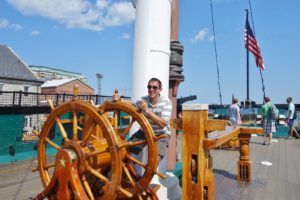 Good Thing DB is Not Manning This Ship!
Good Thing DB is Not Manning This Ship!
Even though she is 217 years old, the ship is still a US Navy commissioned war ship. She was restored in 1927 and is currently in dry dock in the Charlestown Naval Yard for a 3 year restoration.
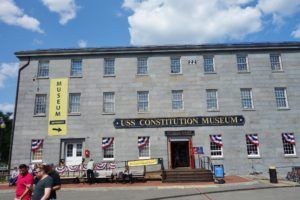 The USS Constitution Museum
The USS Constitution Museum
Next door to the this floating piece of history is the USS Constitution Museum, which houses interactive exhibits including current attractions that let you “explore the harsh realities” of being a sailor on the ship and an in-depth exploration of the War of 1812. The museum is run by a non-profit board and has a suggested donation of $20 for families.
Following the red brick path through Charlestown to the final stop on the Boston Freedom Trail, you pass some classic brownstone buildings and can’t help but think about Ben Affleck’s movie The Town, which takes place in this city.
Even for a Saturday afternoon in July, it was a rather quiet and peaceful walk to the sixteenth site, the Bunker Hill Monument.
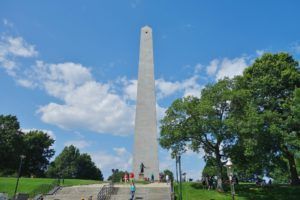 The Bunker Hill Monument
The Bunker Hill Monument
The monument marks The Battle of Bunker Hill, the first time the colonists held their own in a battle against the British, even though they did eventually lose the battle. Today a 221 ft. granite obelisk stands on Breed’s Hill where most of the fighting actually took place. This testament to the spirit of America marks the site of the first major battle of the American Revolution fought on June 17, 1775.
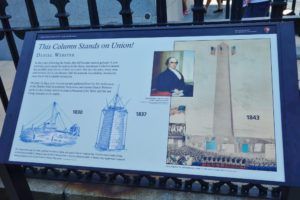 Learning More About the Bunker Hill Monument
Learning More About the Bunker Hill Monument
If you are so inclined, and in rather good shape, you can climb 294 steps to the top for a great panoramic vista of the city. You can also walk through the Bunker Hill Museum which depicts the story of the battle and monument. A great photo op can be had right in front of the monument with a statue of William Prescott who coined the phrase- “Don’t fire until you see the whites of their eyes”.
The Princess had done enough walking by the time we got to the Monument, so we agreed not to make the climb. Having walked the entire 2.5 mile trek in about 3 hours, none of us were in the mood to take the trek back to our hotel. Luckily, we got an Uber car to pick us up and bring us back to Beacon Hill, saving us time and energy for a night out in Beantown!
Final Thoughts on the Boston Freedom Trail
With amazing weather, some family, and a persistence to see everything, our three hour self-guided tour of the Boston Freedom Trail was a great way to spend a summer day. For those traveling to the city during the New England cruise season, I can imagine no better way to see the city, than by following the red brick line through the historic neighborhoods of Boston.
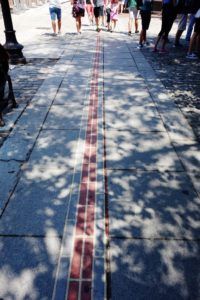 Follow the Red Brick Line to Explore the Boston Freedom Trail
Follow the Red Brick Line to Explore the Boston Freedom Trail
If we had more time, this trip could have easily been expanded by touring some of the museums that are part of the trail or by making a pit stop in the North End for some lunch or dessert. Some of these attractions do have an admission fee, but you can essentially replicate our tour for little to no costs, making the Boston Freedom Trail a great Boston excursion for the entire family.
Comments
Have you explored the Boston Freedom Trail or visited any of these historic places? Do you enjoy exploring historically important sites during your travels? What is your favorite thing to do while visiting Boston? Drop us an anchor below to help your fellow cruisers make the most of their time in Boston.
